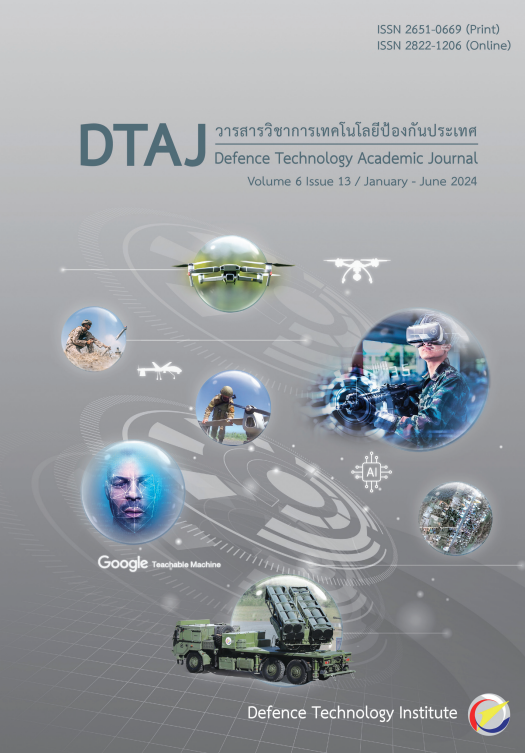Classification of Weapons using Convolution Neural Networks Suitable for Portable Devices
Main Article Content
Abstract
This article aims to study the process of developing a process for classifying 8 types of weapons from image data using deep learning models, which contribute to the process of using computer vision technology to recognize images and describe weapons accurately and efficiently automatically. This process eliminates errors in analyzing large amounts of image data with human error and reduces the data size for use on portable devices. In this article, there are also models developed to distinguish specific subclasses of aircraft that can be equipped with combat equipment and general aircraft. These aircraft are difficult to classify due to similar physical characteristics, such as color, size, and shape. Therefore, this paper uses TensorFlow and Keras, a library for developing machine learning with artificial convolutional neural network algorithms. In this work, the convolutional neural network is used for the model. The performance of the deep learning model is also improved along with a comparison of 8 pre-trained models. According to the results of this study, the EfficientNet-B0 model has a weapon classification accuracy from image data of 94.01%. Additionally, this work uses features of the TensorFlow Lite library to convert parameters into models. The model is processed using integer-based computation to use quantization principles to reduce the size of the parameters to compare the features, size, latency, and accuracy with parameters The final model is mobile-compatible and is suitable for use on portable devices. The experimental results of the int8 model are the smallest, with an accuracy of 88.64%.
Downloads
Article Details

This work is licensed under a Creative Commons Attribution-NonCommercial-NoDerivatives 4.0 International License.
Journal of TCI is licensed under a Creative Commons Attribution-NonCommercial-NoDerivatives 4.0 International (CC BY-NC-ND 4.0) licence, unless otherwise stated. Please read our Policies page for more information...
References
P. Cheewaprakobkit, “Improving the Performance of an Image Classification with Convolutional Neural Network Model by Using Image Augmentations Technique,” TNI J. Eng. Technol., vol. 7, no. 1, pp. 59 - 64, Jan. - Jun. 2019.
K. Chauhan and S. Ram, “Image Classification with Deep Learning and Comparison between Different Convolutional Neural Network Structures Using Tensorflow and Keras,” Int. J. Adv. Eng. Res. Dev. (IJAERD). vol. 5, no. 2, pp. 533 - 538, 2018.
Google LLC Kaggle. (2024). Datasets Explore. [Online]. Available: https://www.kaggle.com/datasets
J. Kukačka, V. Golkov, and D. Cremers, “Regularization for Deep Learning: A Taxonomy,” ArXiv, pp. 1 – 23, 2017, doi: 10.48550/arXiv.1710.10686.
S. Ioffe and C. Szegedy, “Batch Normalization: Accelerating Deep Network Training by Reducing Internal Covariate Shift,” ArXiv, pp. 1 - 11, 2015, doi: 10.48550/arXiv.1502.03167.
A. Budhiman, S. Suyanto, and A. Arifianto, “Melanoma Cancer Classification Using ResNet with Data Augmentation,” 2019 International Seminar on Research of Information Technology and Intelligent Systems (ISRITI), Yogyakarta, Indonesia, 2019, pp. 17 - 20, doi: 10.1109/ISRITI48646.2019.9034624.
N. Srivastava, G. Hinton, A. Krizhevsky, I. Sutskever, and R. Salakhutdinov, “Dropout: A Simple Way to Prevent Neural Networks from Overfitting,” J. Mach. Learn. Res., vol. 15, no. 56, pp. 1929 - 1958, 2014.
Tensorflow for Mobile & Edge (2024). Datasets Explore. [Online]. Available: https://www. tensorflow.org/lite/examples/image_classification/overview
สถาบันเทคโนโลยีป้องกันประเทศ (องค์การมหาชน) กระทรวงกลาโหม. “แผนที่นำทางเทคโนโลยีป้องกันประเทศ พ.ศ. 2553 - 2567.” DTI.or.th https://www.dti.or.th/download/file/e7dd8350.pdf (accessed ก.พ. 28, 2565).
N. Dwivedi, D. K. Singh, and D. S. Kushwaha, “Weapon Classification Using Deep Convolutional Neural Network,” in 2019 IEEE Conf. Inf. Commun. Technol., Allahabad, India, 2019, pp. 1 - 5, doi: 10.1109/CICT48419.2019.9066227.
M. J. N. V. S. K. Asrith, K. P. Reddy, and Sujihelen. “Face Recognition and Weapon Detection from Very Low Resolution Image,” in 2018 Int. Conf. Emerg. Trends Innov. Eng. Technological Res. (ICETIETR), Ernakulam, India, 2018, pp. 1 – 5, doi: 10.1109/ICETIETR.2018.8529108.
L. Zhu and P. Spachos, “Towards Image Classification with Machine Learning Methodologies for Smartphones,” Mach. Learn. Knowl. Extr., vol. 1, no. 4, pp. 1039 – 1057, Oct. 2019, doi: 10.3390/make1040059.
M. A. Abu, N. H. Indra, A. H. A. Rahman, N. A. Sapiee, and I. Ahmad, “A Study on Image Classification based on Deep Learning and TensorFlow,” Int. J. Eng. Res. Technol., vol. 12, no. 4, 2019, pp. 563 - 569.
N. Lamsamut and S. Valuvanathorn,“Stroke Disease Classification on Computerized Tomography Scan Images Using Convolutional Neural Network” in 17th Nat. Conf. Comput. Inf. Technol. (NCCIT2021), Bangkok, Thailand, 2021, pp. 43 - 48.
C. Chousangsuntorn, T. Tongloy, S. Chu wongin, and S. Boonsang, “A Deep Learning System for Recognizing and Recovering Contaminated Slider Serial Numbers in Hard Disk Manufacturing Processes,” Sensors, vol. 21, no. 18, p. 6261, Sep. 2021, doi: 10.3390/s21186261.
Keras Applications. (2024). Datasets Explore. [Online].Available: https://keras.io/api/applications/
A. Géron, “Confusion Matrix” in Hands-on Machine Learning with Scikit-Learn, Keras, and TensorFlow Concepts, Tools, and Techniques to Build Intelligent Systems, N. Tache, Ed., 2nd ed. California, CA, USA: O’Reilly Media, 2019, pp. 92 - 106. [Online]. Available: http://oreilly.com/catalog/errata.csp?isbn=9781492032649


